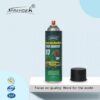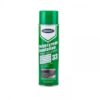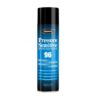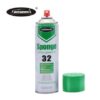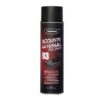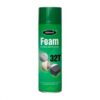Spray adhesives offer some advantages over contact adhesives when it comes to gluing foam together. But it’s also important to note here that several different types of foam spray adhesives are used for different purposes.
The goal of this post is to help you choose the right foam spray adhesive for your project. Read on to learn everything you need to know before you buy spray glue for a project that involves the use of foam.
Factors to consider when choosing spray adhesive for foam
The most important factor to consider is the type of foam you are working with. However, there are some other things to consider as well. Let’s dig into the factors.
Type of foam
The type of foam is mainly determined by its porosity. How well a particular adhesive will adhere depends on the porosity of the foam. Open cell foams like polystyrene and polyethylene have relatively higher porosity levels. In contrast, closed-cell foam such as polyurethane is known for low porosity.
Adhesion strength
Not all foam spray adhesives have the same adhesion strength. And you have to choose a product depending on the project you are working on. For high-density foam, which is thick, contact adhesive is usually a better option because it provides a very strong bond.
If you still want to use spray adhesive for high-density foam, choose an adhesive that offers a strong bond. And you can definitely rely on a low-tack adhesive when working with styrofoam, polystyrene or any other low-density foam.
Price
While high-quality spray adhesives are relatively expensive, they offer greater performance. With that said, the price also depends on the particular brand. Of course, some good brands offer products at affordable rates.
Volatility and odor
Spray adhesives contain volatile organic compounds (VOCs) which, when inhaled, can be bad for humans. These adhesives also contain odors that can be unpleasant. Therefore, if possible, avoid foam spray adhesives with high VOCs and strong odors.
Best spray adhesives for foam
Below, we are going to discuss some of the best foam spray adhesives for various use cases. Learn about the options and decide which particular product you need for your project.
1.Sprayidea 97
For automotive headliners
Whether you are a vehicle repairer, interior manufacturer or DIY enthusiast, you can rely on Sprayidea 97. It is the best glue for foam when it comes to gluing lining materials such as foam, fabric, plastic or leather. This glue is fast-drying, clear, and does not damage the color and texture of the materials.
Specifications:
- Effect time: 3-5 minutes
- Strength: 6000-7000mPa.s/25℃
- Temperature resistance: -30℃-120℃
- Scent: Low odor
- Coverage: 5-6 sq/bottle
- Anti-aging: 5-6 years
- Shelf life: 24 months
2.Sprayidea 33
Best spray foam glue for thermal insulation
Sprayidea 33 is designed for thermal insulation, which often involves the uses of foam, rubber, foil, and rock wool. It has a low soak-in property and provides high initial tackiness. The adhesive is low odor, low corrosion, and eco-friendly. And thanks to the adjustable nozzle, the operation is flexible.
Specifications:
- Effect time: 30-60 seconds
- Temperature resistance: -30℃to 65℃
- Scent: Low odor
- Coverage: 8-12㎡
- Anti-aging: 3-5 years
- Spray pattern: Web
- Shelf life: 24 months
3.Sprayidea 96
Pressure sensitive foam spray adhesive
Wondering what to use to glue foam when the foam is supposed to receive some pressure? If your project requires fast and aggressive tack, you can choose Sprayidea 96. You can use it with foam, polypropylene or leather.
It is the strongest glue for foam that is intended to withstand pressure. The adhesive offers some room for repositioning, thanks to its relatively long open time. The product is user friendly and eco-friendly, and does not corrode the materials.
Specifications:
- Effect time: 30-60 seconds
- Temperature resistance: -30℃to 65℃
- Scent: Low odor
- Coverage: 8-12㎡
- Anti-aging: 3-5 years
- Spray pattern: Web
- Shelf life: 24 months
4.Sprayidea 32
Best foam adhesive for insulation
Sprayidea 32 is the best spray adhesives for bonding foam, sponge, carpet, leather, underlay, wallpaper or plastic. You can use this glue to bond these materials to themselves or other substrates such as metal, wooden board, wall or glass. The product is suitable for both high-density and low-density foam.
Specifications:
- Effect time: 30-60 seconds
- Temperature resistance: -30℃to 65℃
- Scent: Low odor
- Coverage: 8-12㎡
- Anti-aging: 3-5 years
- Spray pattern: Web
- Shelf life: 24 months
5.Sprayidea 93
Best spray adhesive for acoustic insulation
Sprayidea 93 is designed as an expanding foam glue for acoustic materials. Such materials include urethane foam, fiber, vinyl, paper, wood, leather, and metal. It is widely used for sound insulation decoration in stadiums, theaters, and studios. The glue is eco-friendly and low-odor, and does not corrode foam. You can rely on Sprayidea if you want to glue foam to wood.
Specifications:
- Effect time: 30-60 seconds
- Temperature resistance: -30℃to 65℃
- Scent: Low odor
- Coverage: 8-12㎡
- Anti-aging: 3-5 years
- Spray pattern: Web
- Shelf life: 24 months
6.Sprayidea 32T
Best foam glue for high-density foam materials
Sprayidea 32T is designed for bonding crest cotton, high-thickness foam, pyramid foam, egg cotton, fabric, carpet, leather etc. This low-odor and non-corrosive foam offers strong bonding. It is perfect for sound-proof decoration and home improvement.
Specifications:
- Effect time: 30-60 seconds
- Temperature resistance: -30℃to 65℃
- Scent: Low odor
- Coverage: 8-12㎡
- Anti-aging: 1-3 years
- Spray pattern: Web
- Shelf life: 24 months
How to glue foam together?
If you have been using foam spray adhesive for a while, you have probably figured out how to use the product the right way. Below are some tips and tricks that may be useful for anyone gluing foam together:
- When bonding pieces of foam to rubber, consider how absorbent and porous the foam is, and choose a foam spray adhesive accordingly.
- Notice the shape of the foam. A large piece of foam may have parts and edges that may not be easy to glue to something else. Be careful when working with these parts.
- For small pieces of foam that require temporary bonding, any spray glue is usually sufficient. But if that foam is supposed to withstand pressure, choose a foam spray adhesive that is particularly designed for that foam.
- Any foam spray adhesive has a drying time that is printed on the canister. However, it is always a good idea to leave the applied foam a bit longer than the recommended time. You will stay on the safe side.
Frequently asked questions about foam spray adhesive
What is the best spray adhesive for bonding foam to foam?
Sprayidea 32T is by far the best foam to foam adhesive. This adhesive is widely used for bonding pyramid foam, egg cotton,and crest cotton. It works with any high-thickness foam used for sound-proof decoration.
Does spray adhesive work on foam?
Compared to contact adhesive, spray adhesive works significantly better on foam. You can also use foam spray adhesive to bond fabric, leather, cardboard, foil, plastic and rubber to themselves and other substrates.
Can you remove adhesive from foam?
A hot air blow dryer can help you remove adhesive from foam. Apply mild heat and then remove the adhesive carefully. The procedure will release unpleasant vapors. So, wear a breathing mask when removing adhesive from foam.
Conclusion
There are various types of foam materials that differ in their composition. And that’s why it’s important to choose a spray adhesive that is specifically designed for the type of foam you are working with. There are some general purpose foam adhesives as well. Of course, you can use such a product depending on your project type.
Now you know what kind of glue to use on foam. The 6 foam spray adhesives we have discussed cover all possible use cases that involve the use of foam. We hope you have read the specifications and are now better prepared to make an informed decision.

